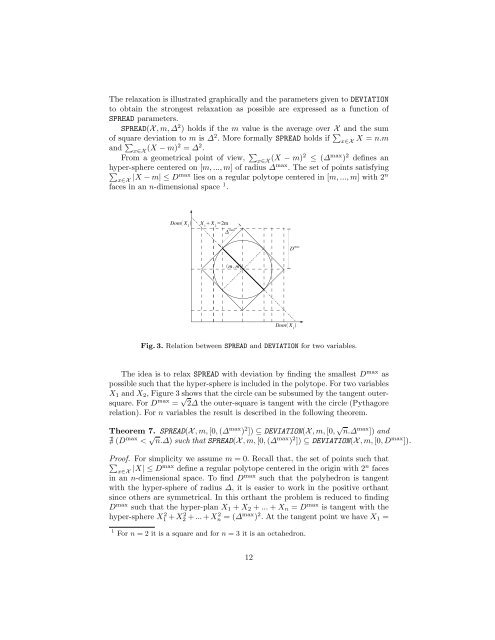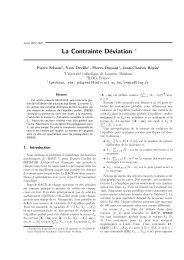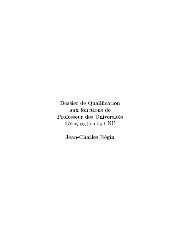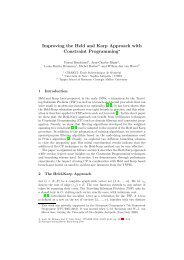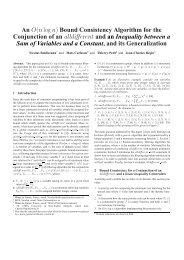The Deviation Constraint - Université catholique de Louvain
The Deviation Constraint - Université catholique de Louvain
The Deviation Constraint - Université catholique de Louvain
Create successful ePaper yourself
Turn your PDF publications into a flip-book with our unique Google optimized e-Paper software.
<strong>The</strong> relaxation is illustrated graphically and the parameters given to DEVIATIONto obtain the strongest relaxation as possible are expressed as a function ofSPREAD parameters.SPREAD(X , m, ∆ 2 ) holds if the m value is the average over X and the sumof square <strong>de</strong>viation to m is ∆ 2 . More formally SPREAD holds if ∑ x∈X X = n.mand ∑ x∈X (X − m)2 = ∆ 2 .From a geometrical point of view, ∑ x∈X (X − m)2 ≤ (∆ max ) 2 <strong>de</strong>fines anhyper-sphere centered on [m, ..., m] of radius ∆ max . <strong>The</strong> set of points satisfying∑x∈X |X − m| ≤ Dmax lies on a regular polytope centered in [m, ..., m] with 2 nfaces in an n-dimensional space 1 .Dom X 2X 1 X 2=2m maxD maxm , mDom X 1Fig. 3. Relation between SPREAD and DEVIATION for two variables.<strong>The</strong> i<strong>de</strong>a is to relax SPREAD with <strong>de</strong>viation by finding the smallest D max aspossible such that the hyper-sphere is inclu<strong>de</strong>d in the polytope. For two variablesX 1 and X 2 , Figure 3 shows that the circle can be subsumed by the tangent outersquare.For D max = √ 2∆ the outer-square is tangent with the circle (Pythagorerelation). For n variables the result is <strong>de</strong>scribed in the following theorem.<strong>The</strong>orem 7. SPREAD(X , m, [0, (∆ max ) 2 ]) ⊆ DEVIATION(X , m, [0, √ n.∆ max ]) and∄ (D max < √ n.∆) such that SPREAD(X , m, [0, (∆ max ) 2 ]) ⊆ DEVIATION(X , m, [0, D max ]).Proof. For simplicity we assume m = 0. Recall that, the set of points such that∑x∈X |X| ≤ Dmax <strong>de</strong>fine a regular polytope centered in the origin with 2 n facesin an n-dimensional space. To find D max such that the polyhedron is tangentwith the hyper-sphere of radius ∆, it is easier to work in the positive orthantsince others are symmetrical. In this orthant the problem is reduced to findingD max such that the hyper-plan X 1 + X 2 + ... + X n = D max is tangent with thehyper-sphere X 2 1 + X 2 2 + ... + X 2 n = (∆ max ) 2 . At the tangent point we have X 1 =1 For n = 2 it is a square and for n = 3 it is an octahedron.12


